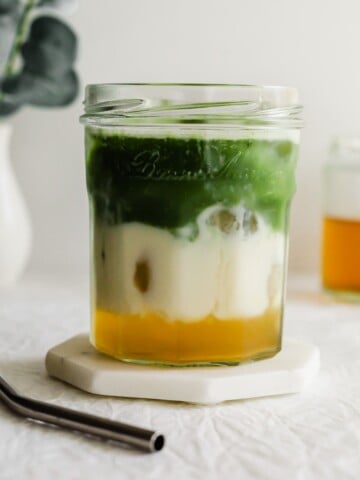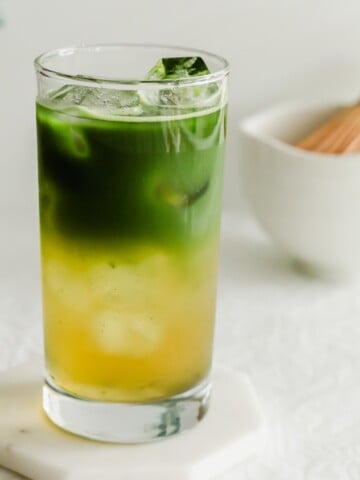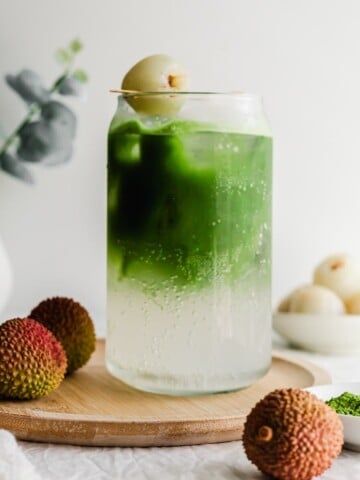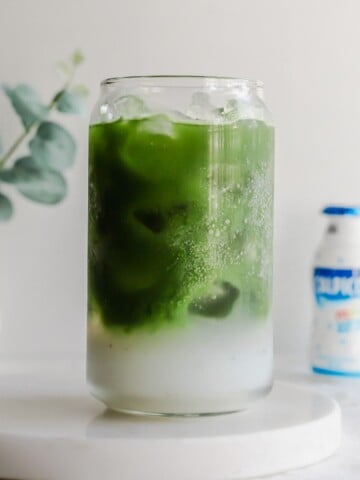What is Matcha tea? How to make it, and how to use it? Find out all about this fine-powdered green tea in this comprehensive matcha guide.

Want to save this recipe?
Enter your email & I'll send it to your inbox. Plus, get great new recipes from me every week!
What is matcha tea?
Matcha (抹茶) is a finely-ground green tea powder from the camellia sinensis plant, traditionally enjoyed in East Asia.
Green tea has its origins in China, and was brought over to Japan in the 12th century.
What is matcha made of?
Matcha powder is made of entire green tea leaves that have been specially grown in the shade.
Shade-grown matcha tea leaves retain high levels of chlorophyll, which gives matcha its bright green colour.
When it comes to harvest time, the tea leaves are removed from the stems and veins.
The tea leaves are then heated through a gentle steaming process and are laid flat to dry.
These flat green tea leaves are known as tencha (before being made into matcha).
From there, the leaves are stone-milled into a fine green powder.
Matcha tea should only contain pure green tea powder, with no other ingredients, fillers or sweeteners.

Differences between traditional tea leaves vs. matcha
Traditional tea leaves go through a similar processing method but do not go through the stone-milling/grinding process.
Depending on the type of tea, the tea leaves can be covered (shade-grown) or uncovered (grown in the sun).
When you think of traditional green tea, you may think of sencha.
Sencha is a type of loose-leaf green tea where its leaves are exposed to the sun.
With traditional green tea, the tea is extracted by steeping/infusing tea leaves in hot water.
Whereas with matcha tea powder, the entire tea leaf is ground up into a fine powder and whisked into hot water.
The matcha powder is suspended in the water and does not fully "dissolve."

Grades
Matcha is not regulated so there's no set guideline on what may constitute a certain "grade."
However, most commonly, there are 2 grades:
Ceremonial grade
High-quality matcha, typically used in traditional Japanese tea ceremony ritual.
Has a bright, vivid green colour, sweet, slightly vegetal taste.
Usually more expensive and has a delicate and sweeter taste due to its higher quality.
It's harvested during ichibancha, which means "first tea" or the first harvest, or the "first flush."
Culinary grade
A "lower" grade than ceremonial, still green in color, but used for everyday matcha lattes, or baking.
Sometimes, there may be a "premium" grade which is in between ceremonial and culinary grade.

What is first flush?
First flush, is ichibancha, which is the first harvest, which happens in the springtime.
Second flush is nibancha is the 2nd harvest, which happens in the summer.
Why does it taste sweeter?
During the winter season, the tea leaves retain much of their nutrients, thereby holding more sweetness, compared to the second flush.
What does matcha taste like
A good quality green tea powder has a sweet, vegetal, slightly grassy, umami flavor and is traditionally enjoyed without sweetener.
Some may describe matcha as bitter.
However, there are ways to counteract this.
How to make matcha taste less bitter
Choose a high-quality powdered green tea.
Look for one that is bright, vivid green in hue, with a pleasant, sweet, grassy scent.
Do not use boiling hot water when preparing the matcha tea.
Use a water temperature of 80 degrees C/176 degrees F, which will not scorch the matcha.
Add agave syrup, honey, maple syrup or sweetener to your taste.
Pair the matcha tea with wagashi, which is a small Japanese sweet treat, usually mochi or a confectionary made with red bean paste.

Traditional tools
Matcha is traditionally prepared in the manner of a Japanese tea ceremony, with a meditative spirit belonging to Zen Buddhism.
The tools used include:
Chashaku: bamboo tea scoop, used for scooping the matcha tea powder
Chasen: bamboo whisk, used for whisking the matcha powder with water
Chawan: literally "tea bowl," a small bowl for preparing and consuming the tea
How to use a matcha whisk to prepare matcha
Use a chashaku (bamboo tea scoop) to add the matcha powder to sieve placed over a chawan (tea bowl).
Sift the matcha into the chawan to remove any clumps.
Pour a little hot water (about 80 degrees C/176 degrees F, not boiling hot) into the bowl and gently press the chasen (whisk) against the bottom of the bowl.
Move the chasen in a zig zag motion until the liquid becomes foamy.
Alternative:
Use an electric whisk/frother or blender.
Top the matcha off with more hot water, or milk of your choice and sweeten to taste if you like.


Types of matcha
Usucha: thin; green tea with hot water, typically prepared for drinking as a tea.
Koicha: thick; made a higher ratio of green tea powder to water; used in Matcha Affogato.

How to use green tea powder in drinks
Add a little matcha to your:
Why should you consume matcha with non-dairy milk
Dairy milk contains a protein called casein that binds to the catechins/antioxidants in matcha, inhibiting their absorption.
This means you receive less health benefits when you drink matcha with milk.
Try a plant-based or non-dairy alterative such as:
- almond milk; pair almonds and green tea in bostock, scones
- oat milk
- soy milk
- coconut milk; I like pairing green tea and coconut together in cakes and coconut balls

Health benefits
Matcha boasts many health benefits since you're ingesting the whole leaf.
It is rich in antioxidants, and l-theanine, which is an amino acid that slows down the absorption of caffeine.
Epigallocatechin-3-gallate (EGCG) EGCG is a catechin/antioxidant that can raise metabolism rates and may aid in weight loss.
It has been shown to lower ldl cholesterol ("bad" cholesterol), amongst other health benefits.
Does matcha contain more caffeine than coffee?
Matcha does contain caffeine, generally lower than 1 cup of coffee.
The amount of caffeine varies depending on the amount prepared.
However, it also contains l-theanine, an amino acid which slows down the absorption of caffeine in the body.
Roasted green tea (hojicha) does not contain caffeine, as it undergoes a heating process.
What's the difference between matcha and hojicha?
Similar to matcha, hojicha is a roasted green tea that is finely milled into a powder.
The main difference is that with hojicha, the tea leaves are roasted over charcoal before it is ground into powder.
Because of that, hojicha is reddish brown in color.
It has a smokier, nuttier flavor compared to matcha.
For more information, read my Beginner's Guide to Hojicha.

Does matcha go bad?
It doesn't go "bad," per se, but when the green tea powder turns a dull yellow/brown color, then it has oxidized.
Nothing wrong with it, but the flavor may not be very aromatic or fragrant, and the resulting color may be not as green.
How to best store matcha
Store the green tea powder in an airtight container in a dark, cool location, away from heat or light.
To prevent it from quickly oxidizing, it's best to keep it in a dark container (not glass or plastic) or solid tin.
You can also store it (in an airtight container) in the fridge to slow down the oxidization.
Where to find matcha powder?
Nowadays, you can find plenty of matcha powder online and in specialty tea shops.
Even some grocery stores carry green tea powder.
However, it's best to stick to well-reputable brands that emulate quality in their product.
How to use matcha powder in baking & desserts
Matcha green tea is a great flavour to add in baking.
It gives baked goods an earthy, umami flavor.
Easily add the green tea powder to cakes, bread, doughnuts, or desserts such as ice cream.
Have a dessert that is too sweet? Add a sprinkle of powdered green tea to tone it down.
I have a category dedicated with more than 50 recipes made with matcha.
Tip: For bright, vivid green colour in your baking, use a high-quality ceremonial grade matcha.
Note: Matcha powder is a drying agent, similar to cocoa powder, so be sure to follow the recipe carefully when adapting with matcha powder.

How to use matcha in savory applications
Matcha can also be used in a savoury way, as in a matcha-flavored salt, especially delicious when paired with fish or potatoes.
Ochazuke is another savory dish consisting of green tea steeped with rice.
My best matcha recipes
Here are some of my best recipes using this versatile green tea powder:
Matcha Milk Jam/Green Tea Milk Spread
Shokupan (Japanese Milk Bread)
Let me know if you tried out this recipe -- tag me on Instagram @siftandsimmer or leave me a comment/rating below!

Matcha Green Tea
For accuracy and precision in baking recipes, use weight (metric) measurements when available.
Ingredients
- ½ teaspoon matcha green tea powder sifted
- ¼ C hot water about 80°C/176°F
- ¼ C additional hot water or steamed milk of your choice (for a latte)
- 1-2 teaspoon sweetener (honey, sugar, maple syrup, agave syrup, etc.) optional, to your taste
Instructions
For key visual process photos, refer to the body of the blog post.
- Use a chashaku (bamboo tea scoop) to add the matcha powder to sieve placed over a chawan (tea bowl).
- Sift the matcha into a chawan (tea bowl) to remove any clumps.
- Pour about ¼ C hot water (about 80°C/176°F, not boiling hot) into the chawan (tea bowl) and gently press the chasen (matcha whisk) against the bottom of the bowl.
- Move the chasen in a zig zag motion until the liquid becomes foamy.
- Or use an electric whisk/frother to froth it up.
- Add additional hot water, or steamed milk of your choice.
- Sweeten with honey, sugar, maple syrup, or sweetener of your choice, to your taste.
Notes
Nutrition
The nutritional information provided should be considered as approximate and is not guaranteed. Please use your best judgment to ensure food is safely prepared and/or a good fit for your diet.






Heidi | The Frugal Girls
This post was such a fun read. I especially loved how you contrasted regular tea leaves with matcha, then explained the different grades of matcha. Now I just need to brew up some tea using your recipe...
Michelle
Thank you so much, Heidi 🙂 Glad to hear that it was a helpful read.
Tasia ~ two sugar bugs
Wow! Such a wonderful list of matcha information. I've just started experimenting with matcha and will definitely be back to this post when I have questions.
Michelle
Thanks Tasia, hope you find it helpful! 🙂
David @ Spiced
This post is so educational! I've long considered you the expert on baking with matcha, and this post backs it up. I'm familiar with matcha, and we often have some in the pantry, but I definitely didn't know all of this background info. Thanks so much for compiling and sharing!!
Michelle
Ahh thank you so much David! Glad to share 🙂
Shruthi
We were recently gifted some ceremonial grade matcha from a friend who returned from Japan and I found this so helpful! Thanks so much - had a fantastic afternoon tea thanks to this post!
Brooke
I love this very informative post. It was so interesting to see that I really don't need to have Matcha with regular milk. Will go with the plant based option for sure!
Michelle
Thanks for reading, Brooke! Plant-based milk is definitely a better choice with matcha 🙂
Sharina
No more store bought matcha tea for me! I love how informative this post is. It is also easy to understand as well. My matcha turned out perfectly well and I'm enjoying it.
Michelle
Thanks for stopping by Sharina, I'm glad the post was helpful 🙂
Kris
I'm new to drinking matcha and this was so helpful and informative! Thank you! 🙂
Michelle
Hi Kris, I'm happy that you discovered matcha! Glad the guide was helpful. Happy tea drinking 🙂
Bella B
Thank you for all the helpful information on matcha. I always get this at Starbucks and decided I needed to learn to make it on my own to save some $. Loved it!
Michelle
Happy to hear it, Bella! Definitely saves you a lot of money making it at home!
Inna Sherman
Hello
can you please share what exactly matcha is on the photos here in the post? brand and exact matcha please if possible. mine is ceremonial but still not so vivid green color. Thank you so much!!!
Michelle
Hi Inna, the matcha powder in these particular photographs were from Junbi (Daily Ceremonial Matcha). Various brands will differ in color, even if they are labeled "ceremonial." Another thing to note is how fresh the matcha is -- if it's been sitting for a while, it will still oxidize. Hope that helps you!